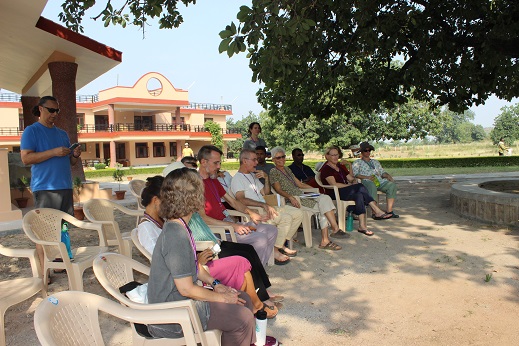
After making it through the last blog (so much history), I thought it was time to share a little of the fun we had on this pilgrimage. As an Ayurveda Health Counselor I love using medicated oils. A great surprise was in store for me and the other pilgrims when Panditji decided to make some triphala/bhringaraj oil. I won’t give you the actual recipe he used, as he made a huge batch (5 gallons) and most of us would never make that much, and also he made it in a real fire pit (which was so awesome) but I doubt that you will want to build this pit by digging up your back yard.
What I will do is share with you my recipe that I use for triphala oil. I learned to make triphala oil in Ayurveda school and have over time, come up with a version of that recipe I like. The use of medicinal oils has been around for a very long time and is referred to as Snehana. Snehana means the application of oil. There is both internal and external snehana. Internal snehana is the consumption of ghee or medicated oil. It also includes soups or other foods with added ghee or oil. External snehana is the application of oily substances to the body. The most common form of this is abyhanga, which means oil massage of the whole body. Certain oils can be used both internally and externally, but the oil Panditji was making today is an external oil only.
Another thing I would like to share with you about snehana from Dr. Lad is that ‘sneha’ means love and compassion, and a loving friend is called ‘snehi’ in Sanskrit. Love is juicy, oily, soft and gentle. These qualities unfold in the conscousness and therefore snehana makes a person loving. Even today in India, newly born babies receive a daily oil massage for three months to convey love and nurturing. As an Ayurvedic coach, I almost always suggest my clients get an oil massage, or learn self-massage in the beginning of using Ayurveda, it usually softens symptoms immediately in many cases.
I will walk you through the pictures of Panditji’s process. First he built a cool fire pit by digging a hole and then a trough off to one side. He then set bricks around the edges leaving space for air to pass through. We of course will use the kitchen stove for my recipe.
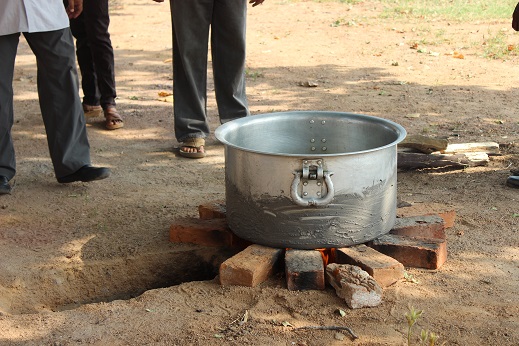
Next he got this huge pot and covered the bottom with wet mud. This will help when cleaning the pot after the process has finished. I like using a stainless steel soup pot.
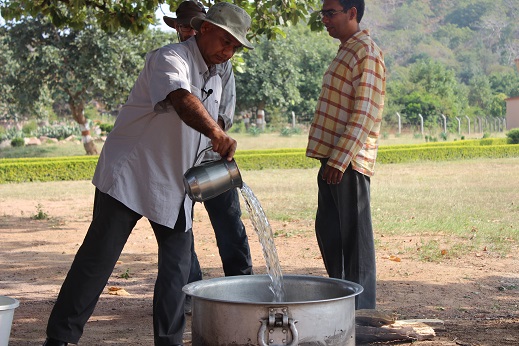
The first thing Panditji added to the pot was water.
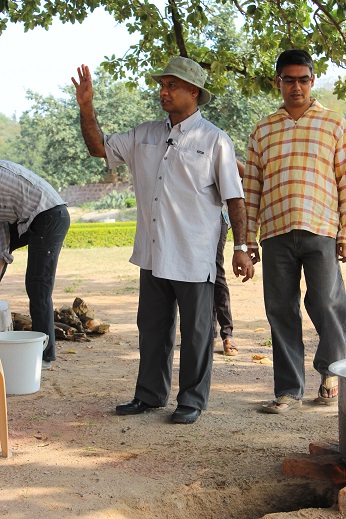
Next a brief explanation of the process to the crowd that watched.
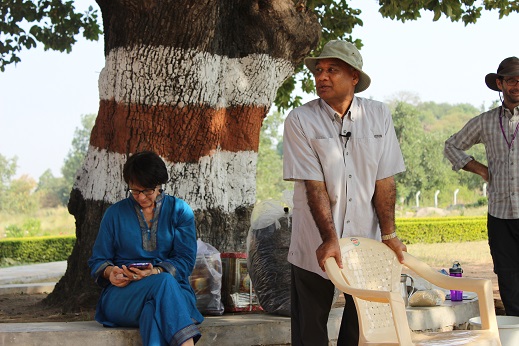
As Panditji is talking, my friend Lea, is taking notes on the oil making procedure

To encourage the water to boil, a lid is added. Joseph, Ishan and Alat discuss the process (I made that up, I don’t know what they are talking about!)
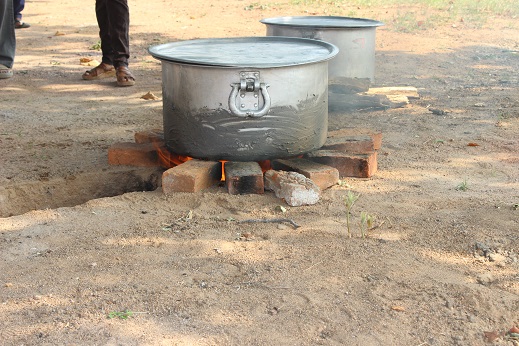
Just waiting for water to boil
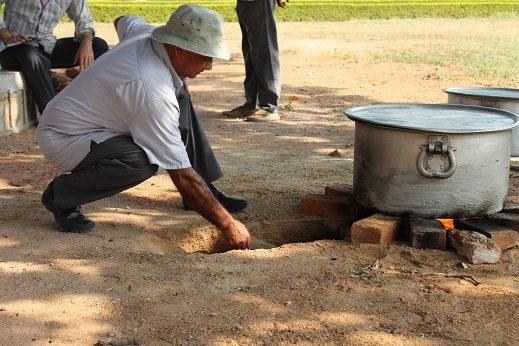
Panditji keeps the fire going by adding more wood through the trough.
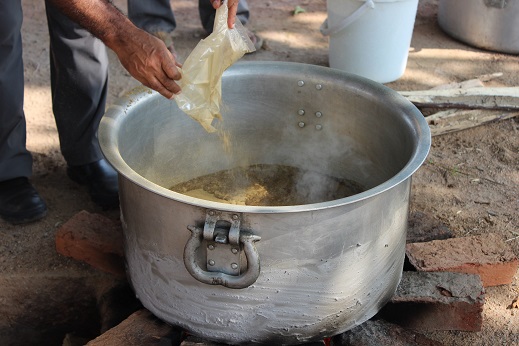
Once the water is boiling, triphala powder is added. Then we let it cook. What exactly is triphala? ‘Tri’ means three and ‘phala’ means fruits. The three fruits of triphala are amalaki, a great balancer of Pitta dosha (fire and water), Bibhitaki, balances Kapha dosha (water and earth) and Haritaki, the balancer of Vata dosha (air and space). Because triphala balances all doshas, it is called tridoshic which makes it a very important herbal mixture in Ayurveda.
Triphala, as I mentioned, is a great balancing formula for detoxificaion and rejuvenation. Because of these properties it is, over all others, the most recommended and used Ayurvedic herbal formulation. Popular for its unique ability to gently cleanse and detoxify the system while simultaneously replenishing and nourishing it. It supports the proper functions of the digestive, circulatory, respiratory and genitourinary systems. Triphala assists natural internal cleansing and removes excess vata, pitta, and kapha from the body. One major reason why most people are familiar with triphala is that it helps maintain regularity. Triphala nourishes and rejuvenates the tissues, supports healthy digestion and absorption and is a natural antioxidant.

Next comes the bhringaraj. We used triphala powder, but now we have actual bhringaraj plant.
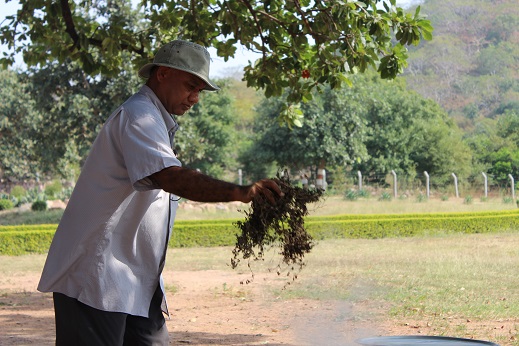
It looked just like a dried plant and Panditji knew (just like a great cook never measures) just how much bhringaraj to add to the triphala water mixture.
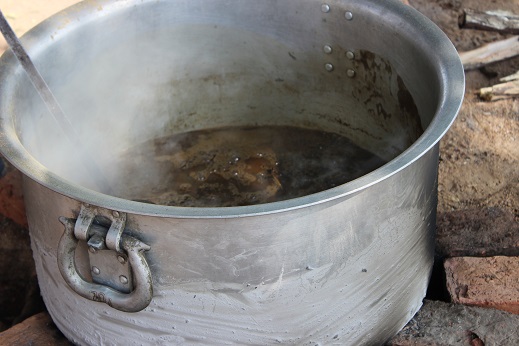
It looks like a tea as the triphala and bhringaraj begin to cook. Bhringaraj is famous in India for its ability to support strong, healthy hair growth. It is known as a powerful hair tonic that helps maintain the hairs natural color and luster. It is also one of the best herbs for pitta and also has a special affinity for the head. Bhringaraj calms the mind while promoting healthy skin, bones, teeth, eyes, hearing and memory. Bhringaraj oil is an excellent choice for massaging the scalp and feet before bed to promote deeply restful sleep.
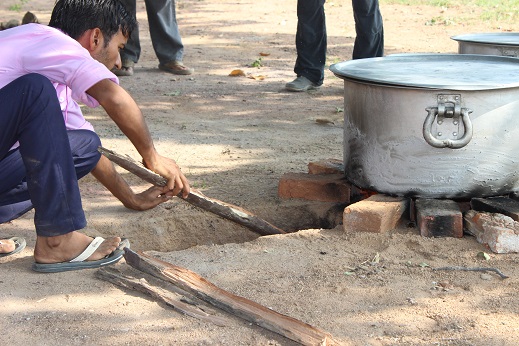
Again, the fire is tended to.
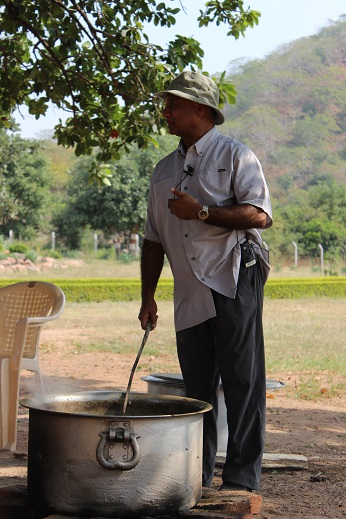
There was some stirring
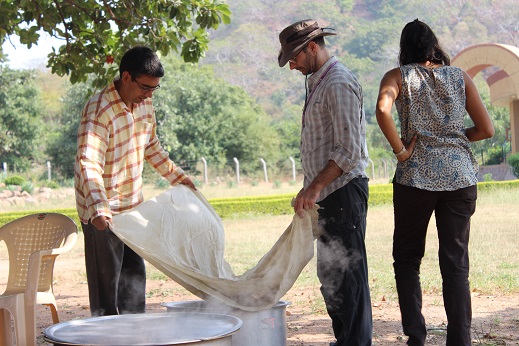
And as the mixture was almost ready to be strained, a huge piece of muslin was draped over a second pot
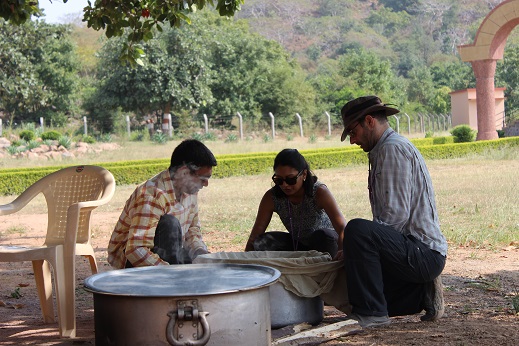
Alat seemed to know the correct tying method and was assisting Ishan and Joseph
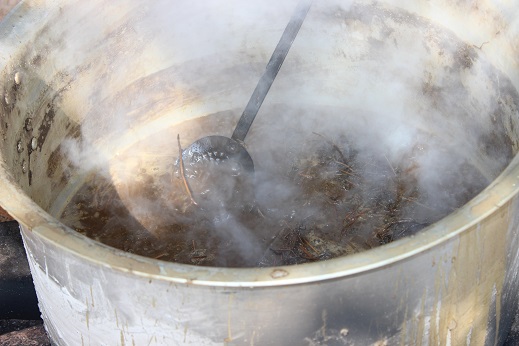
I few more stirs and it was ready to go
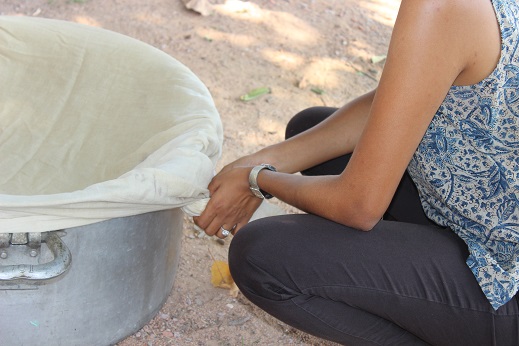
This is the second pot (the one the mixture is being poured in to). I strain mine into a giant measuring cup and then I wipe out the original pot and then pour the mixture back in.
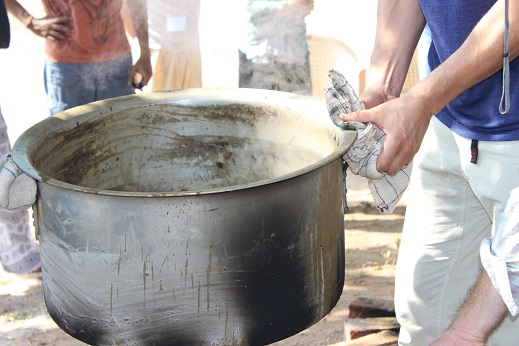
The pot was heavy and it took some maneuvering to pick it up and tilt it to pour
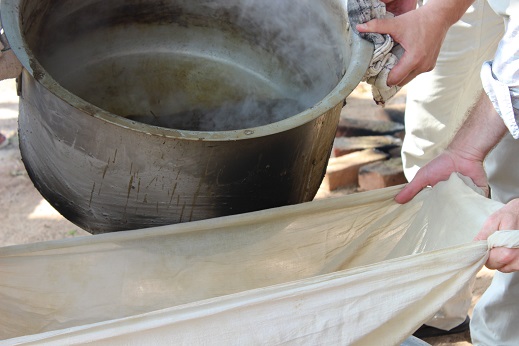
As the mixture was being strained, the ends of the cloth were picked up and held.
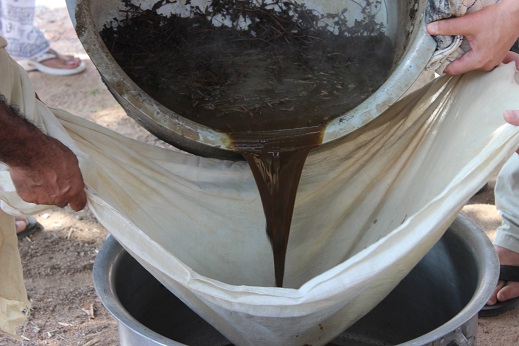
I use a very tight meshed strainer first, as I am pouring the triphala mixture into the measuring cup. When I pour the mixture back into the pot, I strain it through the muslin cloth.
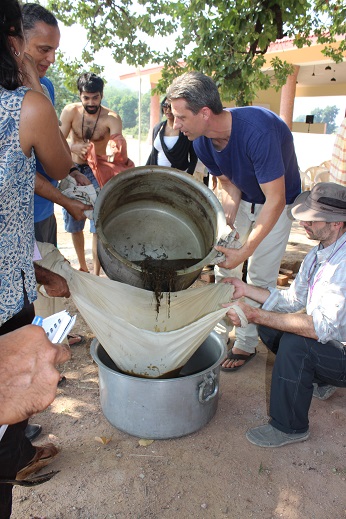
Lots of helpers to get this done…Luke and Leonel to the rescue
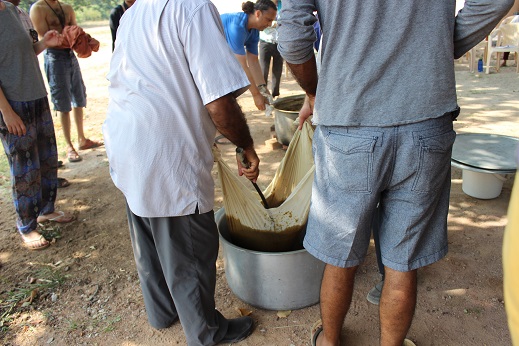
The mixture of left over branches and such was then pressed on by the big spoon to push all the juice through the cloth
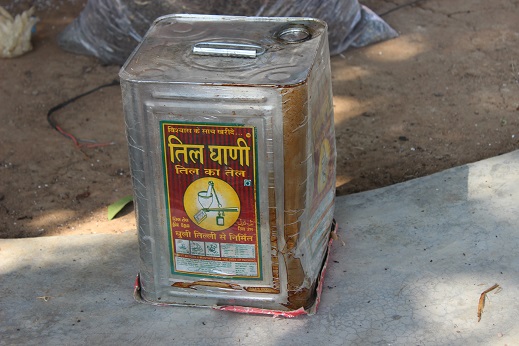
Next comes the oil. Panditji used sesame oil and I do also. Panditji and Ishan discuss the correct amount of oil to use. This was entertaining, a perfect father/son discussion. Any bets on who won that one? LOL
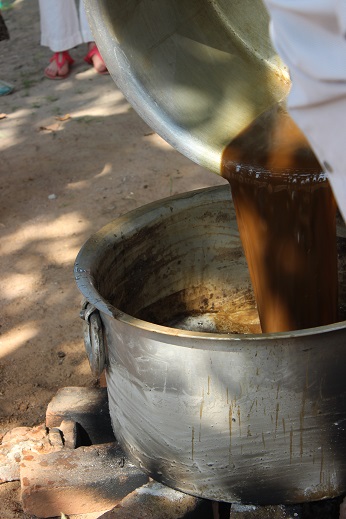
The oil was then added to the triphala/bhringaraj mixture. (You always add oil to the mixture vs. the mixture to the oil)
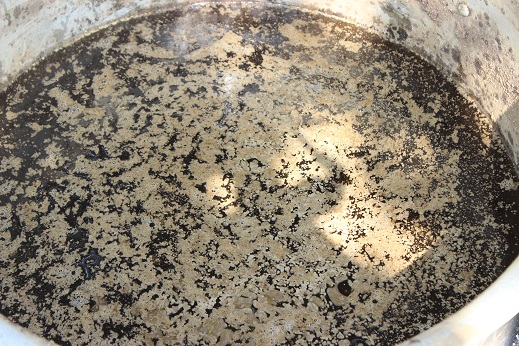
Looks very interesting!
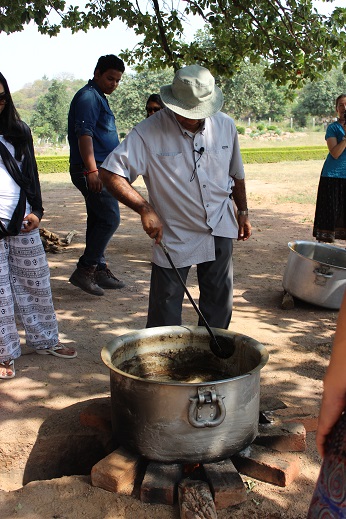
Again like any great concoction, you have to get the good stuff off the sides of the pot!
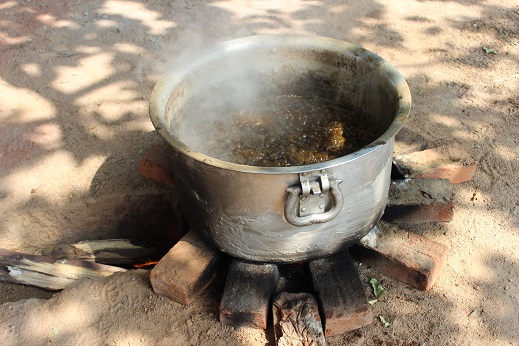
The mixture begins to boil as the excess water is then cooked away.
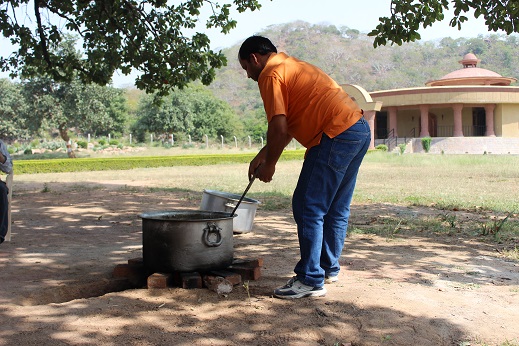
More stirring still. This is a good time to point out that if you make this at home, do it with friends so you can share the work.
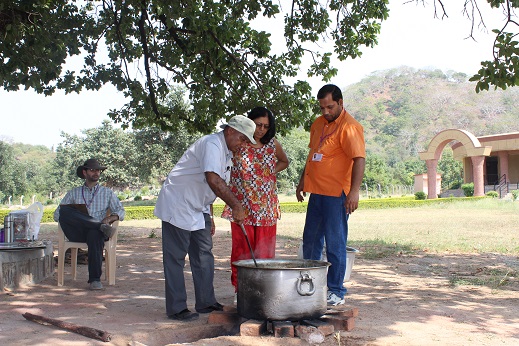
Here Meera comes to check it out
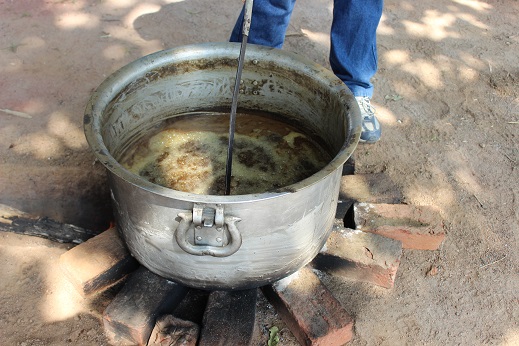
By now the oil was really getting beautiful and clear as it finished cooking.
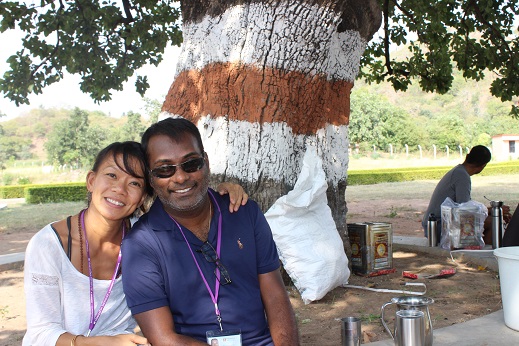
Projects like this are so much fun and a great bonding experience for us all. Here Ruby and Navin pose for a photo.
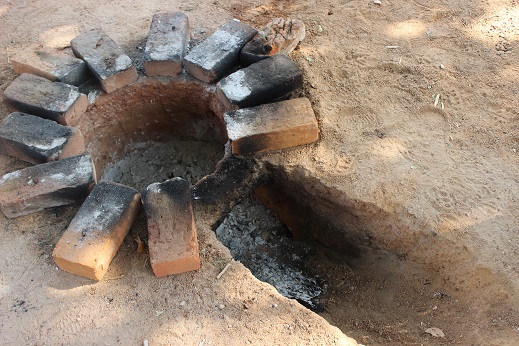
One last look at the fire pit, I loved it, it reminded me of camping!
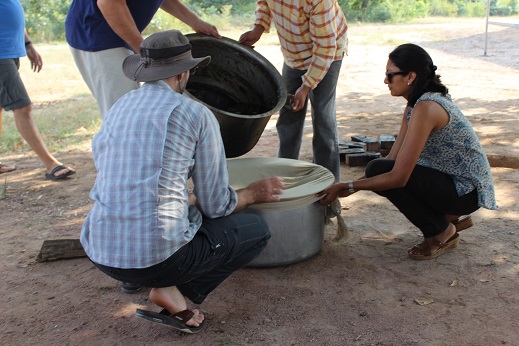
One last straining.
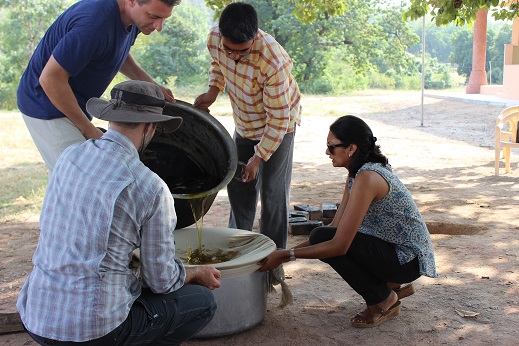
You can see how beautiful the oil is.
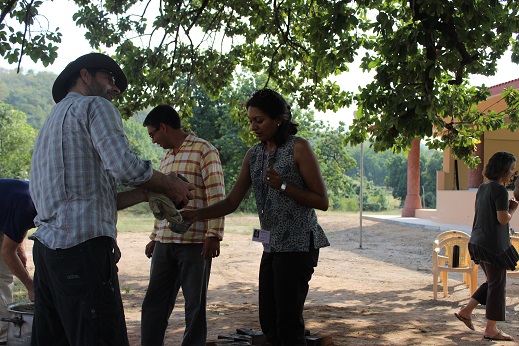
We are now finished and the oil is cooling before it is put into plastic bottles for us to purchase and take home.
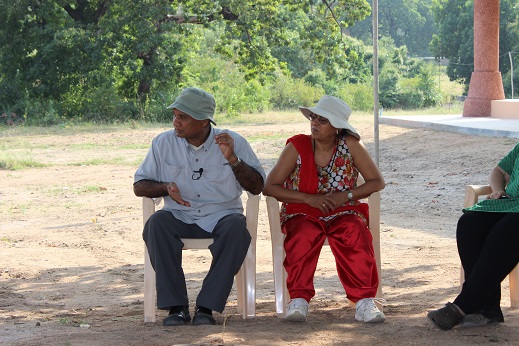
Then we all sat around and talked and thanked Panditji for sharing this fun time.
Peggy’s Triphala Oil Recipe
Make a decoction of the triphala herbs by cooking 1 part dry herbs to 16 parts water. An example would be 1/4 cup triphala with 4 cups water. Boil the herbs slowly over a low flame until the water is reduced to one-quarter its original amount. For example, 4 cups should be reduced to 1 cup. Then strain out the herbs. This process takes several hours. Theliquid can be used a a prepared medicinal decoction, but in this case, you are going to use it for your medicated oil. Finally mix equal parts sesame oil and herbal decoction, and cook it over a low flame until all the water evaporates.
